United Kingdom and Republic of Ireland
September 7 - 20, 2003
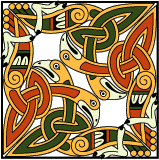
| CELTIC ADVENTURE United Kingdom and Republic of Ireland September 7 - 20, 2003 |
 |
![]()
Kathy and I looked at many options for seeing the UK and Ireland and decided that Globus' Celtic Highlights trip offered the itinerary that most closely matched what we wanted to see in the time we allowed. The Globus brochure has a scale for this trip that has "Leisurely" on the left and "On the Go" on the right and this trip was marked all the way toward "On the Go". They weren't kidding! I don't think I've ever packed so much into two weeks of traveling. I'll just try to describe the "highlights" of this trip as we saw enough towns, sites, etc. to fill a book.
We arrived in Glasgow, Scotland at 9 a.m. approximately 19 hours after leaving California. Our tour director Mary met us at the airport and we were soon on our way to our hotel. Even though we both didn't get much sleep on the flights and our bodies were telling us it was really 3 a.m., we decided to catch some of the sights of Glasgow on foot. This was one of only two half-days that we had free on the entire trip and we took advantage of the time. We saw the 13th century Cathedral, St. Mungo Museum of Religious Life and Art which houses Salvador Dali's Christ of St. John of the Cross, Provand's Lordship - Glasgow's oldest surviving house built in 1471 and Tenement House which is a time capsule of how people lived during the early 20th century. This tenement house was owned by Agnes Toward and it looks as if she stepped out for a minute 70 years ago and forgot to return. That night in our hotel, we met the other 44 people we would be traveling with for the next two weeks.
The next day, we met our driver Derek, boarded the coach and headed to the Highlands of Scotland. This area is characterized by moors - broad tracts of wasteland covered with heather. We followed the Caledonian Canal and saw several scenic lochs (lakes) including Loch Ness. Unfortunately, "Nessie" must have been on holiday also as we never spotted her/him/it. I had my first of many fish and chips meals when we stopped for lunch at Ft. William. Our final stop was the Culloden battlefield where the last battle on British soil took place. On April 16, 1746, the Jacobites (Scottish clans) led by Bonnie Prince Charlie were crushed by the Hanoverian troops commanded by the Duke of Cumberland. This battle ended Scotland's hopes for independence from England.
During the drive, we saw several Highlands cows. They look like Texas longhorns except they have long brown hair - very strange looking. We ended up at the Highland resort town of Grantown-on-Spey where we stayed overnight.
Our first stop the following day was the Glenlevit whisky distillery. I really like these types of tours where you learn how things are made as long as they don't try to give you the high-pressure sales pitches afterward (they didn't). We were shown how barley, yeast and water are converted into whisky - a very complex process. At the end of the tour we got to taste samples of three types of whisky distilled there. Even though I am not a whisky drinker and it was only 9:30 in the morning, I had to try all the samples. The 30-year whisky was supposed to be smooth but I'll take beer any day.
Shortly after leaving the distillery, our coach broke down. Apparently, a belt broke. We limped into the next small town and we all got free drinks at the Blue Jay Pub while the bus was supposedly being fixed. They didn't have the right belt so they had to call for a replacement coach and driver. We ended up in St. Andrews a few hours late but still got to see the old golf course and the Royal and Ancient Golf Club founded in 1754. St. Andrews is the very first golf course and some of the die-hard golfers in our group were worried that the shops would be closed by the time we arrived. They did find an open shop to purchase golf balls, etc. so everyone was happy. We continued on to Edinburgh arriving at our hotel at 8:30 p.m. We found a Pub called Dirty Dick's and had an excellent dinner there. We also had our first glance of the Edinburgh Castle which dates to the 12th century and sits high atop the basalt core of an extinct volcano. It was all lit up and the full moon was just above it - quite a sight.
The next day, we went on the city tour of Edinburgh, which included an all too short tour of the castle, and the Holyrood Palace which was built in 1529. It is now the Royal family's official Scottish residence. Our local guide Tom was decked out in the traditional kilt outfit. After the tour we saw that the National Gallery had a special exhibit of over 80 Monet paintings. Monet just happens to be Kathy's favorite artist so we saw the exhibit along with the rest of the National Gallery.
| We decided that an hour at the castle wasn't enough so we walked back up to it and got back in free by telling the guard that we were on the bus tour in the morning. We spent another couple of hours there exploring the castle, it's museums and the great view of Edinburgh. Afterwards, we walked down the Royal Mile which goes through the old town. The John Knox house is the oldest house there dating from 1490. By the time we got back to our room, we both agreed that Edinburgh was a special city. |  John Knox House Edinburgh, Scotland |
I really liked Scotland but the next day we had to hit the road and head south. We passed right by the town of Lockerbie where a terrorist bomb brought Pam Am flight 103 crashing to earth back in 1988 killing all 259 people on board and 11 people on the ground. In the lake district of England, we drove through spectacular Kirkstone Pass and stopped for lunch at Bowness-on-Windermere. This area is considered the finest national park in England. Our next stop was Chester, a historic town on the river Dee. This was one of my favorite towns on this trip. It has well-preserved Roman ruins, a great clock tower and picturesque black and white timber buildings dating to the 13th century called Rows. We ended up in Wales where we stayed in the 13th century Ruthin Castle that was converted into a Best Western hotel. I've never stayed in a Best Western like this one. It has beautiful grounds, a dungeon, dozens of Peacocks and a ghost wondering the grounds. They call her the Grey Lady and she was executed after she murdered her husband's lover. This was quite a day - we had breakfast in Scotland, lunch in England and dinner in Wales.
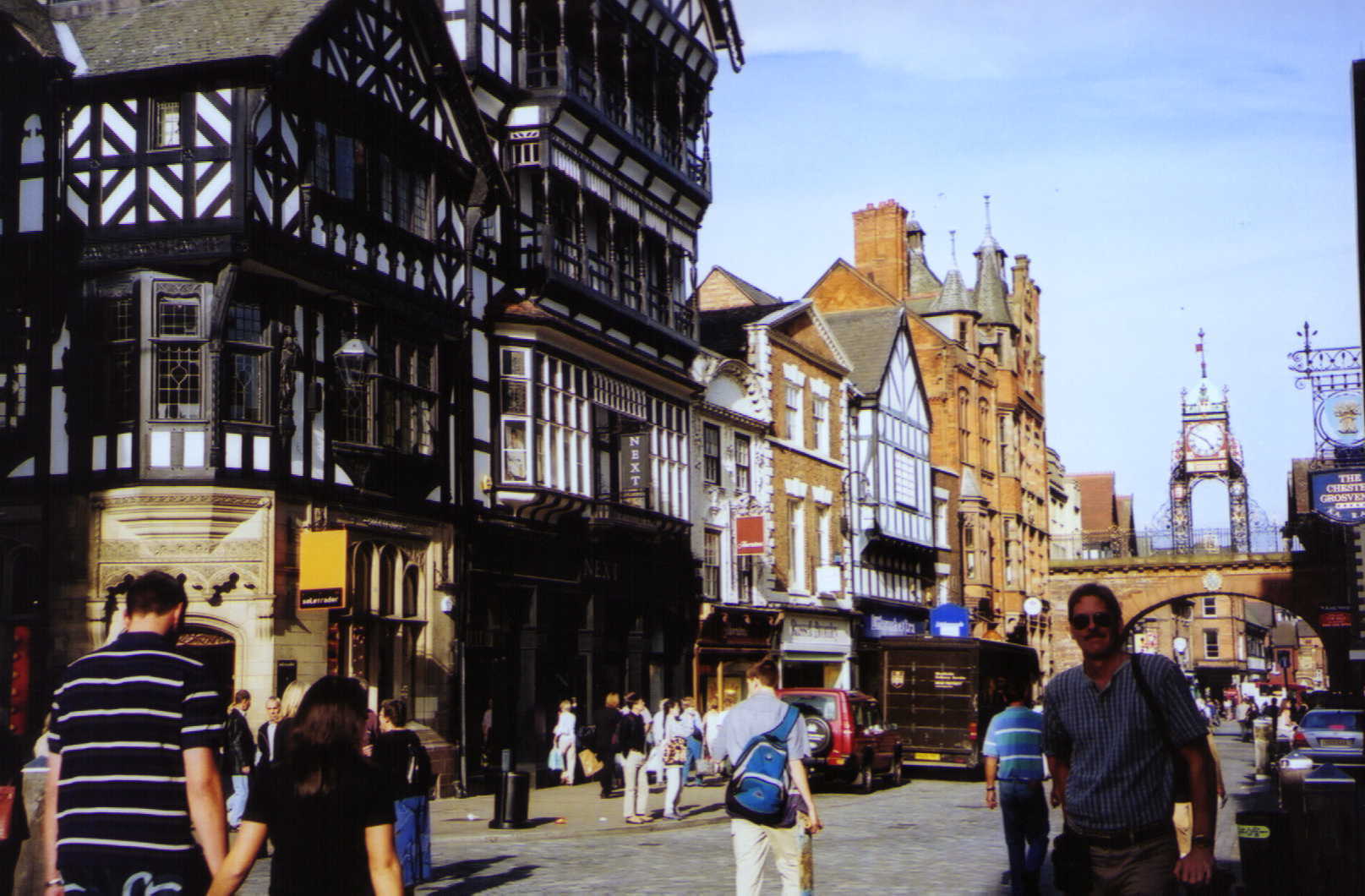 Chester, England |
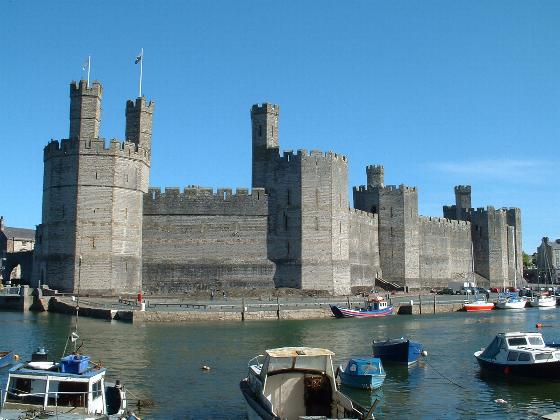 Caernarvon Castle, Wales |
I got up around 3:00 a.m. to look out the window for the Grey Lady but there were no sightings that night. After breakfast, it was back on the coach and a tour through spectacular mountain passes and the beautiful scenery of Snowdonia National Park. We saw Mt. Snowdon (3,360') and stopped at Betws-y-Coed and Caernarvon. The castle in Caernarvon is where Charles was invested as Prince of Wales. We also stopped at Llanfairpwllgwyngyllgogerychwyrndrobwllllantysiliogogogoch. Yes that is really the name of the town. It is Welsh and translates into The Church of Mary in the Hollow of the White Hazel Near the Fierce Whirlpool and the Church of Tysilio by the Red Cave.
We boarded our ferry at Holyhead to cross the Irish Sea to Ireland. The ferry we used is the HSS Stena Explorer. It is one of the new high-speed ships and cruises at 40 knots or 46.6 mph. The crossing was fairly smooth and only took about 1½ hours. We docked at Dun Laoghaire, which is the port for Dublin.
We stayed in Dublin and the next day got a tour of the city. We saw Oscar Wilde's house and across the street, there is a memorial park with a statue of Oscar Wilde sitting on a rock. The statue is made out of different colored marble. There are some of his quotes printed on some pedestals - some humorous, some profound. We also saw St. Patrick's Cathedral, the National (Art) Museum and Dublin Castle.
We noticed hundreds of people walking around the city all wearing the same red jersey and found out that they were all rooting for Cork in the Guinness All-Ireland Hurling Final being played in Dublin that day. Hurling is not a sport played after drinking massive quantities of Guinness. It is a game similar to hockey that is played with a small ball and a curved wooden stick. It is Europe's oldest field game brought to Ireland by the Celts as the last ice age was receding. Kilkenny beat Cork 1-14 to 1-11 so there were a lot of disappointed (but well-behaved) fans walking around after the game.
We visited the famous Trinity College in Dublin. In the library there, the famous Book of Kells is on display. The Book of Kells is the richest, most copiously illuminated, manuscript version of the four Gospels in the Celto-Saxon style that still survives, dating from the 9th century. It contains incredible Celtic illumination including abstract patterns of diverging and interlocking spirals, interlocking ribbons, torques of braided wires and frets. I have always been fascinated by Celtic art so this was a real treat.
The first night in Dublin, we had a typical Irish meal (Irish stew) at a pub and sampled some great Irish beer - Smithwick's and Guinness. Then we found another pub and since the weather was so nice, we sat outside and enjoyed a few more Irish beers.
The second night in Dublin, we signed up for the optional Irish Cabaret, which happened to be at the hotel we stayed at. The show included dinner and Irish coffee. The performers included riverdancers, Tony Kenney (a famous? Irish singer) and Joe Cubby - a comedian that had me and most of the crowd in stitches.
From Dublin, we drove to Kildare and visited the Irish National Stud Farm. We saw a few champion racehorses, some miniature horses and a Japanese garden there. Further down the road, we stopped at the Rock of Cashel where St. Patrick once preached and ended up in Blarney. We decided against doing the tourist thing - kissing the Blarney Stone located in the castle there. I guess we won't have the gift of eloquence now but I did purchase some Waterford Crystal at a large shop there.
We ended up in the town of Tralee. That night we took another optional tour to a pub located on the Dingle Peninsula where the husband and wife owners performed all the famous Irish songs for us - The Rose of Tralee, It's a Long Way to Tipperary, My Wild Irish Rose, Danny Boy, When Irish Eyes are Smiling, etc. When we left for our hotel, we were full of good spirits and gazed upon a beautiful sunset over Dingle Bay.
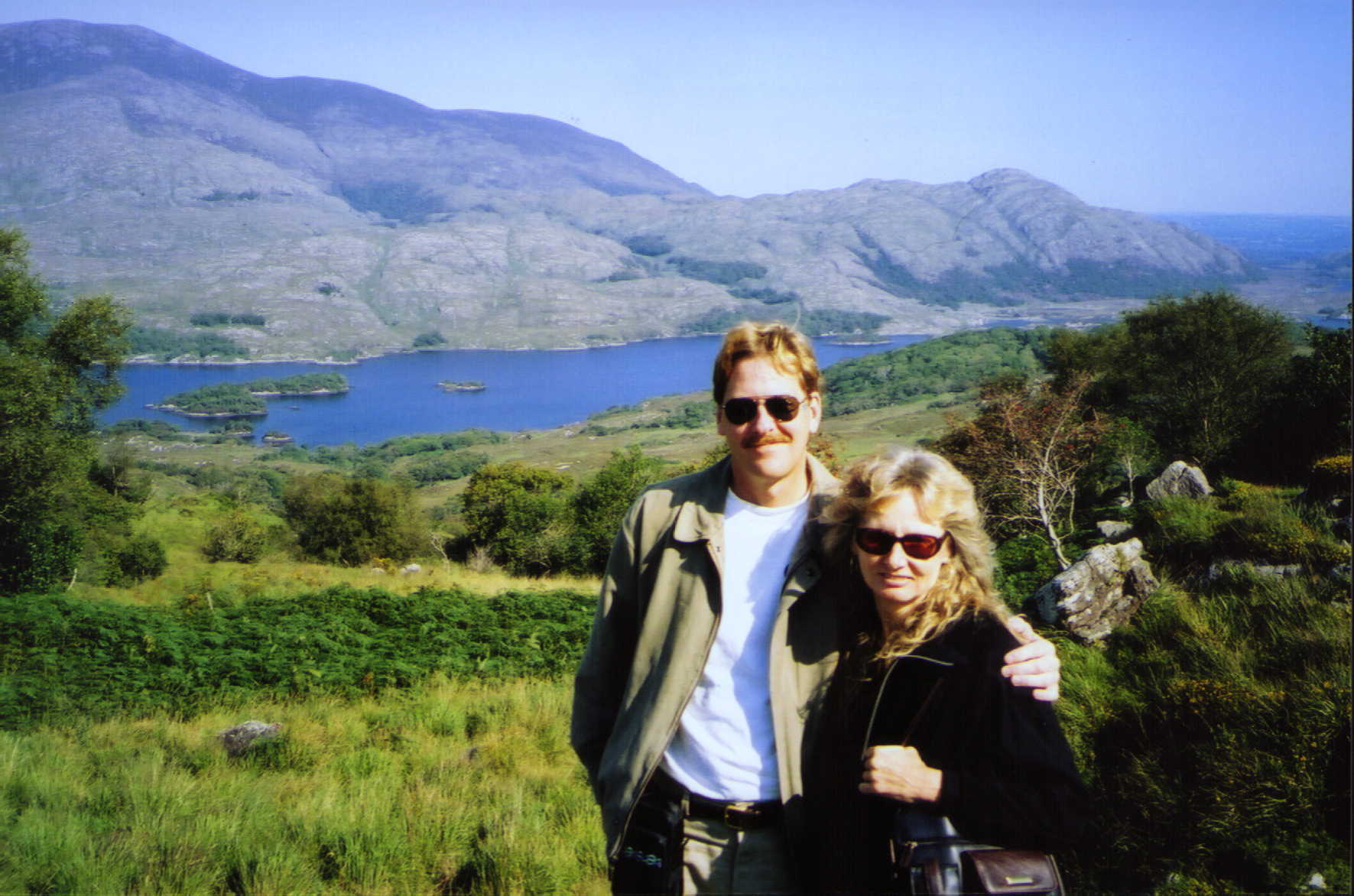 Ring of Kerry, Ireland |
The next day, we saw the famous Ring of Kerry. The Ring of Kerry is a 100-mile scenic drive around the southwestern tip of Ireland. It includes the rugged coast, mountains, valleys, a lot of sheep and the Lakes of Killarney. The weather was perfect and the scenery was spectacular. We continued on stopping in Adare and ending up in Limerick. |
That night we took our third optional tour held in Knappogue Castle. It was a mediaeval show complete with costumed Butler and Ladies of the Castle, a glass of mead to warm us up and dinner.
Leaving Limerick the next day, we headed north. The first stop was the Cliffs of Moher. The cliffs rise 668 feet above the Atlantic Ocean - pretty spectacular. We hiked up to an observation tower that afforded a grand view of the cliffs. We continued on stopping at Galway and Cong where the film The Quiet Man with John Wayne and Maureen O'Hara was filmed. I called Cong "The Quiet Town" as it was pretty dead when we were there.
After an overnight stay in Sligo, we crossed the border into Northern Ireland and got a tour of the Belleek Pottery Factory. We were shown all the stages of creating this outstanding pottery/china. One part that I found amusing was when I saw these big, burley, Guinness - guzzling macho guys painting dainty flowers on vases.
The next stop was Derry (officially known as Londonderry). This is where we got a history lesson of "The Troubles" from our local guide. The Catholic majority of Ireland had been fighting for independence from British rule since the 19th century. In 1921, the partition of Ireland took place. Six counties in the north were predominantly Protestant and voted to stay with the United Kingdom. The other 26 counties were of Catholic majority and became the Irish Free State but it is a lot more complicated than just a dispute between the Catholics and Protestants. Many political and paramilitary groups have emerged over the years. Sinn Féin (Irish for "ourselves alone") is the political wing of the Irish Republican Army (IRA). The British have troops stationed there to keep the peace but 3,000 people died during the "The Troubles" from 1968 to 1998 when the Good Friday agreement brought the fighting to a stop. Former President Clinton had a big role in negotiating the agreement and he is very popular there.
In Derry, we had a short walking tour and saw the old city walls, a police station that looked like a fortress and St. Columb's Cathedral. We stopped at a building (courthouse?) where an inquiry is going on regarding the Bloody Sunday massacre that occurred in 1970 when British troops fired upon people demonstrating against unfair housing laws. The most interesting sights were political murals painted on the side of buildings in both the Unionist and Republican sections of Derry.
After Derry, we headed to the Giant's Causeway, which is composed of thousands of strangely symmetrical basalt columns that jut out to sea between Port Ganny and Port Noffer. Legend has it that the whole causeway was built by the Irish giant, Finn MacCool so he could travel across the sea to Scotland. This would have been a great place to hike for at least a whole day but unfortunately, we only had enough time to watch the film in the visitor's center and take the shuttle bus to the Causeway and back. Also, we had the worst wind and rain of the whole trip here. We were lucky we weren't swept out to sea while trying to walk on the formations.
From the Giant's Causeway, it was short drive along the coast to Ballygally Castle where we spent the night. The castle had a tower with a "Ghost Room" so Kathy and I walked up the spiral staircase to check it out. The room has a few odd items in it and when Kathy pulled back the covers of the bed, a large fake spider appeared. The Ghosts were shy as we didn't see any. In the morning, we were able to check out the beautiful grounds before boarding the coach.
|
Our next stop was Belfast. Our local guide there was much more upbeat than our guide in Derry. She was very happy that the teenagers now had a place to go dancing and have a good time - something she couldn't do growing up during "The Troubles". We saw the shipyard where the Titanic was built as well as a memorial to the victims. We also saw the Europa Hotel. Former President Clinton stayed there but its real claim to fame is it held the record of most bombed hotel - 42 times in all. A Baghdad hotel now holds that dubious record. |
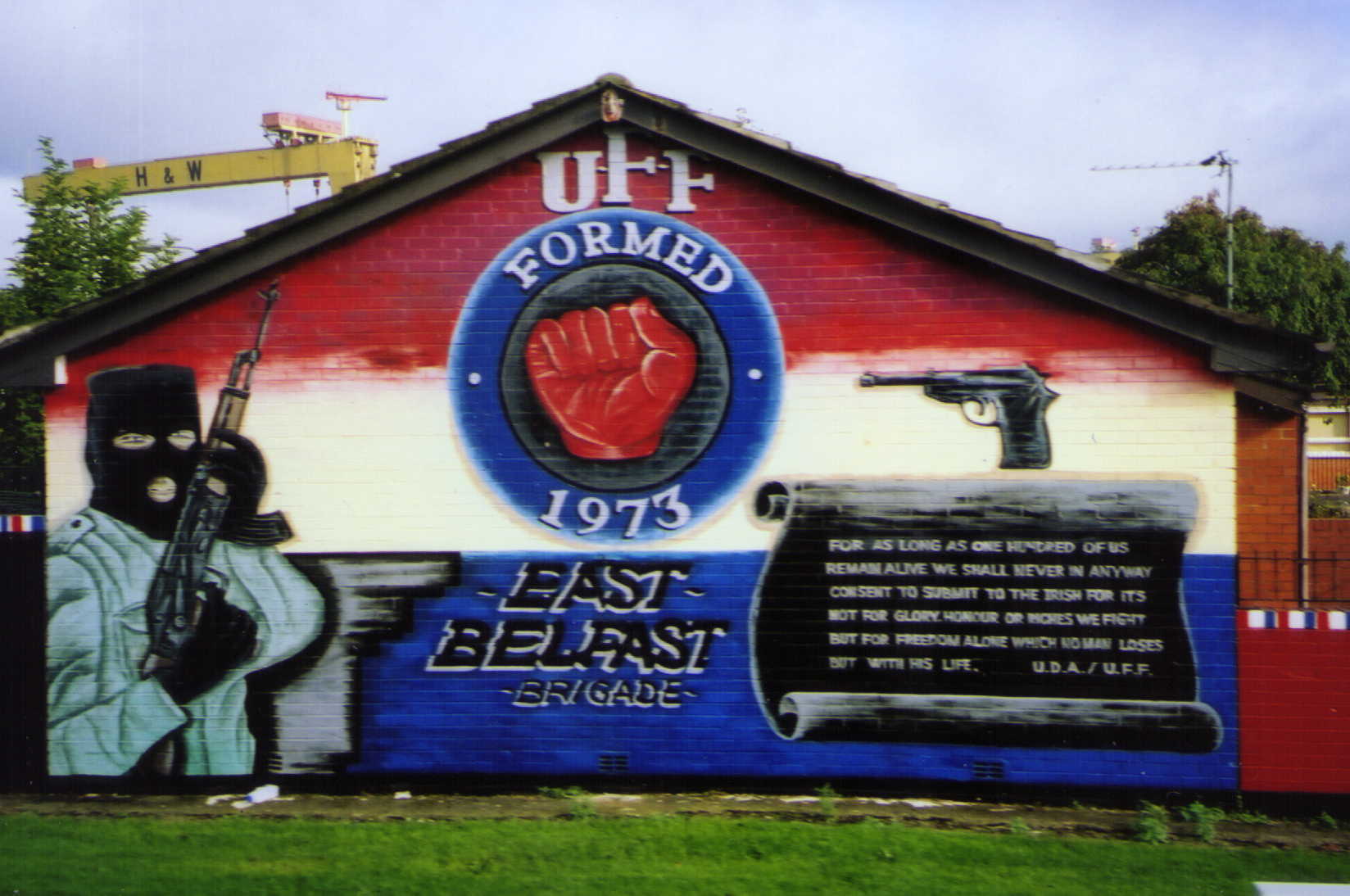 Unionist (Ulster Freedom Fighters) Mural in Belfast, Northern Ireland |
Belfast is also a divided city with colorful political murals on buildings in both sections of the city. We saw one mural dedicated to Bobby Sands who was the first person to die in prison of a hunger strike in the 1980's. He and others were jailed without being charged with anything.
Our local guide told us that Protestants and Catholics live next to each other in relative harmony in the more affluent neighborhoods and that it is mostly the working class and poor who can't get along. It was quite surprising then that while we happened to be driving through an affluent neighborhood, we saw British troops with automatic weapons patrolling on both sides of the street. I guess they figured they were less likely to get shot at there.
After our tour of Belfast, we boarded another high-speed ferry that took us back to Scotland. That night, the whole group got together for drinks before our farewell dinner. During the dinner, some of the people wrote a song for Mary and Derek and we all sang it to them. The next day was a long travel day back to Sacramento.
We traveled almost 1,800 miles on the coach. This coach seemed slightly more cramped than the two Trafalgar Tours coaches I rode in but I survived. The food except for some breakfasts was really good. Derek did a great job driving and Mary was a good tour director, mixing history and humor. She even mailed me 20 Euros that I won on the Irish Lottery and couldn't collect while there. The weather was pretty good overall. Before we arrived, the UK and Ireland had a big drought with no rain for over a month. In the two weeks we were there, it rained only 4 days. That's still not bad as one Brit told Kathy on the ferry: "It only rains twice a week in Ireland, once for four days and once for three days". But if it weren't for all the rain, Ireland wouldn't be the "Emerald Isle".
This was a great way to see and do a lot in a short time. Unfortunately for me, other than the Roman ruins in Chester, we didn't get to see any of the ancient sites that I'm really interested in: Hadrian's Wall, stone circles and Celtic sites. I think the car and bed and breakfast deals would be a good way to go even though gas is around $5.00 a gallon in Scotland (the highest price in Europe) and only slightly less in the rest of the UK and Ireland. Whatever mode of transportation is used - coach, car or rail, the UK and Ireland are definitely worth seeing.
